Early Dental Care
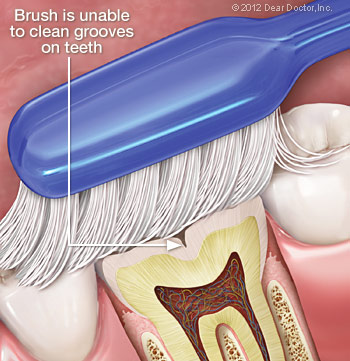 The most likely location for a cavity to develop in your child’s mouth is on the chewing surfaces of the back teeth. Run your tongue over this area in your mouth, and you will feel the reason why: These surfaces are not smooth, as other areas of your teeth are. Instead, they are filled with tiny grooves referred to as “pits and fissures,” which trap bacteria and food particles. The bristles on a toothbrush can’t always reach all the way into these dark, moist little crevices. This creates the perfect conditions for tooth decay.
The most likely location for a cavity to develop in your child’s mouth is on the chewing surfaces of the back teeth. Run your tongue over this area in your mouth, and you will feel the reason why: These surfaces are not smooth, as other areas of your teeth are. Instead, they are filled with tiny grooves referred to as “pits and fissures,” which trap bacteria and food particles. The bristles on a toothbrush can’t always reach all the way into these dark, moist little crevices. This creates the perfect conditions for tooth decay.
What’s more, a child’s newly erupted permanent teeth are not as resistant to decay as adult teeth are. The hard enamel coating that protects the teeth changes as it ages to become stronger. Fluoride, which is found in toothpaste and some drinking water — and in treatments we use here at the dental office — can strengthen enamel, but, again, it’s hard to get fluoride into those pits and fissures on a regular basis. Fortunately, there is a good solution to this problem: dental sealants.
Dental sealants are invisible plastic resin coatings that smooth out the chewing surfaces of the back teeth, making them resistant to decay. A sealed tooth is far less likely to develop a cavity, require more expensive dental treatment later on, or, most importantly, cause your child pain.
How Sealants Are Placed
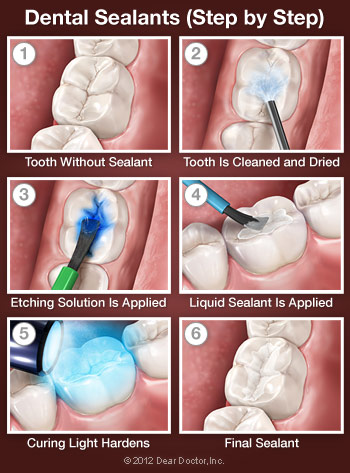 You can think of a sealant as a mini plastic filling, though please reassure your child that it doesn’t “count” as having a cavity filled. Because tooth enamel does not contain any nerves, placing a sealant is painless and does not routinely require numbing shots. First we will examine the tooth or teeth to be sealed, and if any minimal decay is found, it will be gently removed. The tooth will then be cleaned and dried. Then we will apply a solution that will slightly roughen or “etch” the surface, to make the sealing material adhere better. The tooth is then rinsed and dried again. The sealant is then painted on the tooth in liquid form and hardens in about a minute, sometimes with the help of a special curing light. That’s all there is to it!
You can think of a sealant as a mini plastic filling, though please reassure your child that it doesn’t “count” as having a cavity filled. Because tooth enamel does not contain any nerves, placing a sealant is painless and does not routinely require numbing shots. First we will examine the tooth or teeth to be sealed, and if any minimal decay is found, it will be gently removed. The tooth will then be cleaned and dried. Then we will apply a solution that will slightly roughen or “etch” the surface, to make the sealing material adhere better. The tooth is then rinsed and dried again. The sealant is then painted on the tooth in liquid form and hardens in about a minute, sometimes with the help of a special curing light. That’s all there is to it!A note about BPA: A 2012 study that received wide press coverage raised concerns that trace amounts of the chemical bisphenol-A (BPA) found in some (but not all) dental resins might contribute to behavioral problems in children. The study authors noted that while they had found an association, they had not actually proven that BPA in dental sealants causes these problems. In fact, BPA is far more prevalent in food and beverage packaging than in dental restorative materials. The American Academy of Pediatric Dentistry and the American Dental Association have since reaffirmed their support for the use of sealants. We would be happy to answer any questions you may have regarding this issue.
Taking Care of Sealants
Sealed teeth require the same conscientious dental hygiene as unsealed teeth. Your child should continue to brush and floss his or her teeth daily and visit us for regular professional cleanings. This will give us a chance to check for wear and tear on the sealants, which should last for up to 10 years. During this time, your child will benefit from a preventive treatment proven to reduce decay by more than 70 percent.
Teething
A baby’s first tooth typically erupts between 6 to 12 months of age. Gums are sore, tender and sometimes irritable until the age of 3. Rubbing sore gums gently with a clean finger, the back of a cold spoon or a cold, wet cloth helps soothe the gums. Teething rings work well. While your baby is teething, it is important to monitor the teeth for signs of baby bottle decay. Examine the teeth, especially on the inside or the tongue side, every two weeks for dull spots (whiter than the tooth surface) or lines. A bottle left in an infant’s mouth while sleeping can cause decay. This happens because sugar in the liquid mixes with bacteria in dental plaque, forming acids that attack the tooth enamel. Each time a child drinks liquids containing sugar, acids attack the teeth for about 20 minutes. When awake, saliva carries away the liquid. During sleep, the saliva flow significantly decreases and liquids pool around the child’s teeth for long periods, covering the teeth in acids.
Preventing Baby Bottle Tooth Decay
Tooth decay in infants can be minimized or totally prevented by not allowing sleeping infants to bottle-feed. Infants that need a bottle to comfortably fall asleep should be given a water-filled bottle or a pacifier.
Infant’s New Teeth
Primary (baby) teeth play a crucial role in dental development. Without them, a child cannot chew food properly and has difficulty speaking clearly. Primary teeth are vital to development of the jaws and for guiding the permanent teeth into place when they replace the baby teeth around age 6. Since primary teeth guide the permanent teeth into place, infants with missing primary teeth or infants who prematurely lose primary teeth may require a space maintainer, a device used to hold the natural space open. Without a maintainer, the teeth can tilt toward the empty space and cause permanent teeth to come in crooked. The way your child cares for his/her primary teeth plays a critical role in how he/she treats the permanent teeth. Children and adults are equally susceptible to plaque and gum problems—hence, the need for regular care and dental check-ups.
Infant Tooth Eruption
A child’s teeth actually start forming before birth. As early as 4 months of age, the primary (baby) teeth push through the gums—the lower central incisors are first, then the upper central incisors. The remainder of the 20 primary teeth typically erupt by age 3. Permanent teeth begin eruption around age 6, starting with the first molars and lower central incisors. This process continues until around age 21. Adults have 28 permanent teeth—32 including the third molars (wisdom teeth).
A Child’s First Dental Visit
A child’s first dental visit should be scheduled around his/her first birthday. The most important part of the visit is getting to know and becoming comfortable with the dental team. A pleasant, comfortable first visit builds trust and helps put the child at ease during future dental visits.
Good Diet and Healthy Teeth
The teeth, bones and soft tissue of the mouth require a healthy, well-balanced diet. A variety of foods from the five food groups helps minimize (and avoid) cavities and other dental problems. Children should receive healthy foods like vegetables, low-fat yogurt and cheeses, which promote strong teeth.
 New parents sometimes anticipate their baby’s first tooth with a mixture of excitement and worry. While reaching a new developmental milestone is always a cause for celebration, this particular one can come with considerable discomfort. However, teething is different for each baby, and need not be painful at all; plus, there are steps you can take to make the process easier for your baby — and yourself.
New parents sometimes anticipate their baby’s first tooth with a mixture of excitement and worry. While reaching a new developmental milestone is always a cause for celebration, this particular one can come with considerable discomfort. However, teething is different for each baby, and need not be painful at all; plus, there are steps you can take to make the process easier for your baby — and yourself.
Teething refers to the process by which primary (baby) teeth emerge through the gums and become visible in the mouth. This usually begins between six and nine months of age, though it may start as early as three months or as late as one year. Usually, the lower front teeth erupt first, followed by the ones directly above. Most children have all 20 of their primary teeth by the age of 3.
Recognizing the Signs
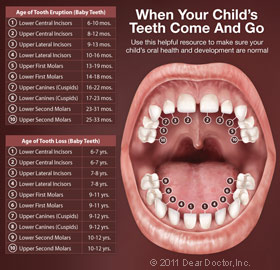 Common signs that your baby is teething include:
Common signs that your baby is teething include:- Irritability
- Biting and gnawing
- Drooling
- Chin rash (caused by excessive salivation)
- Swollen gums
- Ear rubbing
- Decreased appetite
- Disrupted sleep patterns
You are most likely to notice any of the above from about four days before the tooth breaks through the gums up until three days after the tooth appears.
A less common teething issue is the formation of an “eruption cyst,” a small bubble-like swelling filled with fluid that covers an erupting tooth. Eruption cysts usually do not require treatment as the tooth will simply pop the cyst when it comes through.
While there has been some disagreement as to whether diarrhea, rashes and fever are signs of teething, these are more likely to be associated with an unrelated illness and should be reported to your pediatrician.
How to Help
Teething babies get the most relief from cold and/or pressure on the affected area. This can be applied with:
- Chilled teething rings
- Cold, wet washcloths
- Chilled pacifiers
- Massaging baby’s gums
Make sure not to actually freeze your baby’s teething ring or pacifier because this could burn if left in the mouth for too long. The outmoded “remedy” of rubbing whiskey or other alcohol on the gums is neither effective nor appropriate. Over-the-counter medication may be helpful, but always check the correct dosage with your pediatrician or pharmacist. These, too, should not be rubbed on the gums because they can burn. Numbing agents shouldn’t be used on babies under age 2 unless directed by a physician.
Finally, if you have any questions or concerns about teething, feel free to contact our office. Remember, it’s best to start dental visits by your child’s first birthday to establish this lifelong health-promoting routine. We look forward to meeting your little one!
Your child won’t keep his or her first teeth forever, but that doesn’t mean those tiny pearly whites don’t need conscientious care. Maintaining your child’s dental health now will provide health benefits well into adulthood, as primary (baby) teeth serve some extremely important functions.
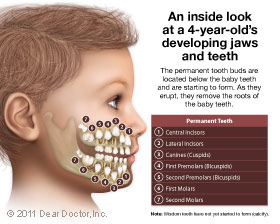 For one thing, primary teeth serve as guides for the eruption of permanent (adult) teeth, holding the space into which these new teeth will erupt. The crowns (tops) of the permanent teeth actually push against the roots of the baby teeth, causing them to resorb, or melt away. In this way, the adult teeth can take their proper place.
For one thing, primary teeth serve as guides for the eruption of permanent (adult) teeth, holding the space into which these new teeth will erupt. The crowns (tops) of the permanent teeth actually push against the roots of the baby teeth, causing them to resorb, or melt away. In this way, the adult teeth can take their proper place.
What’s more, your child’s primary teeth will be there for most of childhood, helping your child to bite, chew and speak. For the first six or so years, he or she will be relying on primary teeth exclusively to perform these important functions. Until around age 12, your child will have a mix of primary and permanent teeth. You will want to make sure those teeth stay healthy and are lost naturally — when it’s time.
You are most likely to notice any of the above from about four days before the tooth breaks through the gums up until three days after the tooth appears.
A less common teething issue is the formation of an “eruption cyst,” a small bubble-like swelling filled with fluid that covers an erupting tooth. Eruption cysts usually do not require treatment as the tooth will simply pop the cyst when it comes through.
While there has been some disagreement as to whether diarrhea, rashes and fever are signs of teething, these are more likely to be associated with an unrelated illness and should be reported to your pediatrician.
Your Child’s First Teeth
 Your child’s 20 baby teeth will begin to appear usually between six and nine months, though in some cases it may start as early as three months or as late as twelve months. The two lower front teeth tend to erupt first, followed by the two upper ones. The first molars come in next, followed by the canines (eyeteeth). Sometimes your baby can experience teething discomfort during this process. If so, let us know and we will advise you as to the best course of action.
Your child’s 20 baby teeth will begin to appear usually between six and nine months, though in some cases it may start as early as three months or as late as twelve months. The two lower front teeth tend to erupt first, followed by the two upper ones. The first molars come in next, followed by the canines (eyeteeth). Sometimes your baby can experience teething discomfort during this process. If so, let us know and we will advise you as to the best course of action.
Your infant’s gums and newly erupting teeth should be gently wiped after each feeding with a water-soaked gauze pad or damp washcloth. Starting at age 2, when there are more teeth in the mouth, establish a daily brushing routine with a small, soft-bristled toothbrush and no more than a thin smear of fluoridated toothpaste. Your child may need your help with this important task until about the age of 6.
Your Child’s First Dental Appointment
The American Academy of Pediatric Dentistry recommends that you bring your child in to see us by his/her first birthday. Though this may sound early, we can teach you proper pediatric oral hygiene techniques, check for cavities, and watch for developmental problems.
There are a number of forms of tooth decay that can affect babies and small children. Early Childhood Caries (tooth decay) can develop rapidly, progressing from the hard, outer enamel layer of a tooth into the softer, inner dentin in six months or less.
Most of all, we want to make sure your child has a positive experience at our office and will be a regular visitor for years to come.
Pediatric Dental Treatments
There are a variety of dental treatments we provide to prevent tooth decay in children, or to save or repair teeth when necessary. They include:
Topical Fluoride — Fluoride incorporates into the enamel of teeth, making it harder and more resistant to decay. Although there is a small amount of fluoride in toothpastes and in some drinking water supplies, we can apply a higher concentration onto your child’s teeth for maximum protection.
Dental Sealants — We can apply a plastic coating that prevents cavities by sealing the little grooves on the chewing surfaces of back teeth known as “pits and fissures.” These little crevices become the perfect environments for decay-causing bacteria. Immature tooth enamel is more permeable and therefore less resistant to tooth decay. Dental sealants are easy to apply and provide years of protection.
Root Canal Treatment — Perhaps you have had a root canal treatment yourself, to save an injured or severely decayed tooth. Well, sometimes children need root canals, too. As mentioned above, baby teeth are important guides to the permanent teeth that are already forming beneath your child’s gums. Therefore, saving them from premature loss can help prevent a malocclusion (“mal” – bad; “occlusion” – bite) that requires orthodontic treatment.
Bonding — Chips and minor fractures to front teeth — common childhood occurrences — can be repaired with tooth-colored bonding materials. These lifelike resins made of plastic and glass can be used on baby teeth as well as permanent teeth and last until the youngster has completed facial growth.
Orthodontic Concerns
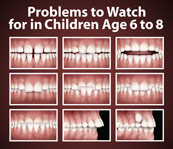 By around age 7, most malocclusions have become evident. Interceptive orthodontic treatment around this time can help direct proper tooth positioning and/or jaw growth, eliminating or simplifying the need for later treatment. There are many orthodontic problems that can be detected early and are examples of why a trained professional should evaluate your child during his/her growth and development.
By around age 7, most malocclusions have become evident. Interceptive orthodontic treatment around this time can help direct proper tooth positioning and/or jaw growth, eliminating or simplifying the need for later treatment. There are many orthodontic problems that can be detected early and are examples of why a trained professional should evaluate your child during his/her growth and development.
Sports & Your Child’s Teeth
If your child is active in sports, we highly recommend a custom-made mouthguard. According to the American Dental Association, an athlete is 60 times more likely to suffer dental harm when not wearing one of these protective devices. We can have a mouthguard custom-made specifically for your child using a model of his or her teeth that will offer greater protection than an off-the-shelf model. It’s an investment that pays off highly in the form of reduced pain, suffering — and dental expenses down the road! Please ask us about mouthguards at your child’s next appointment.
